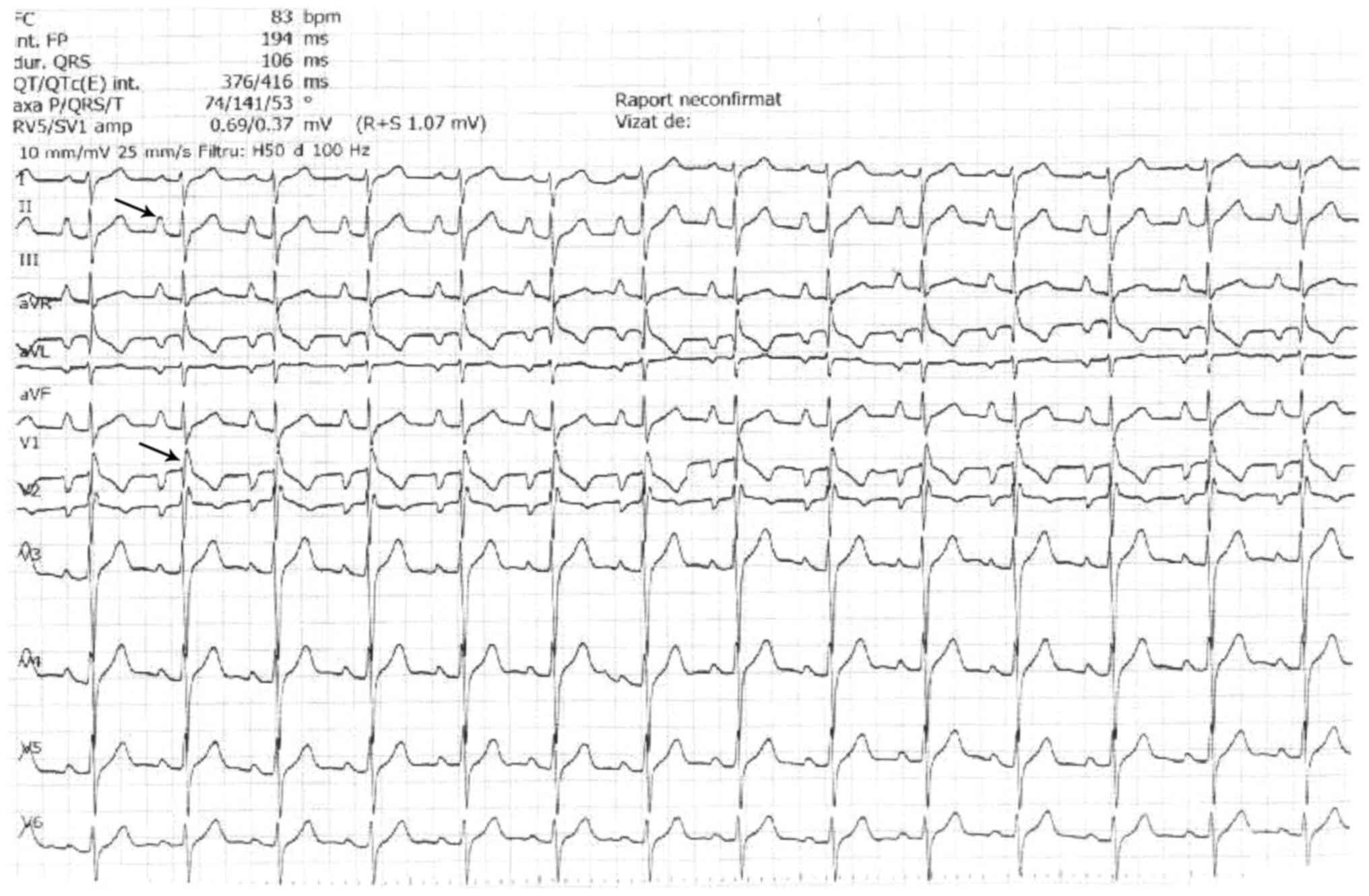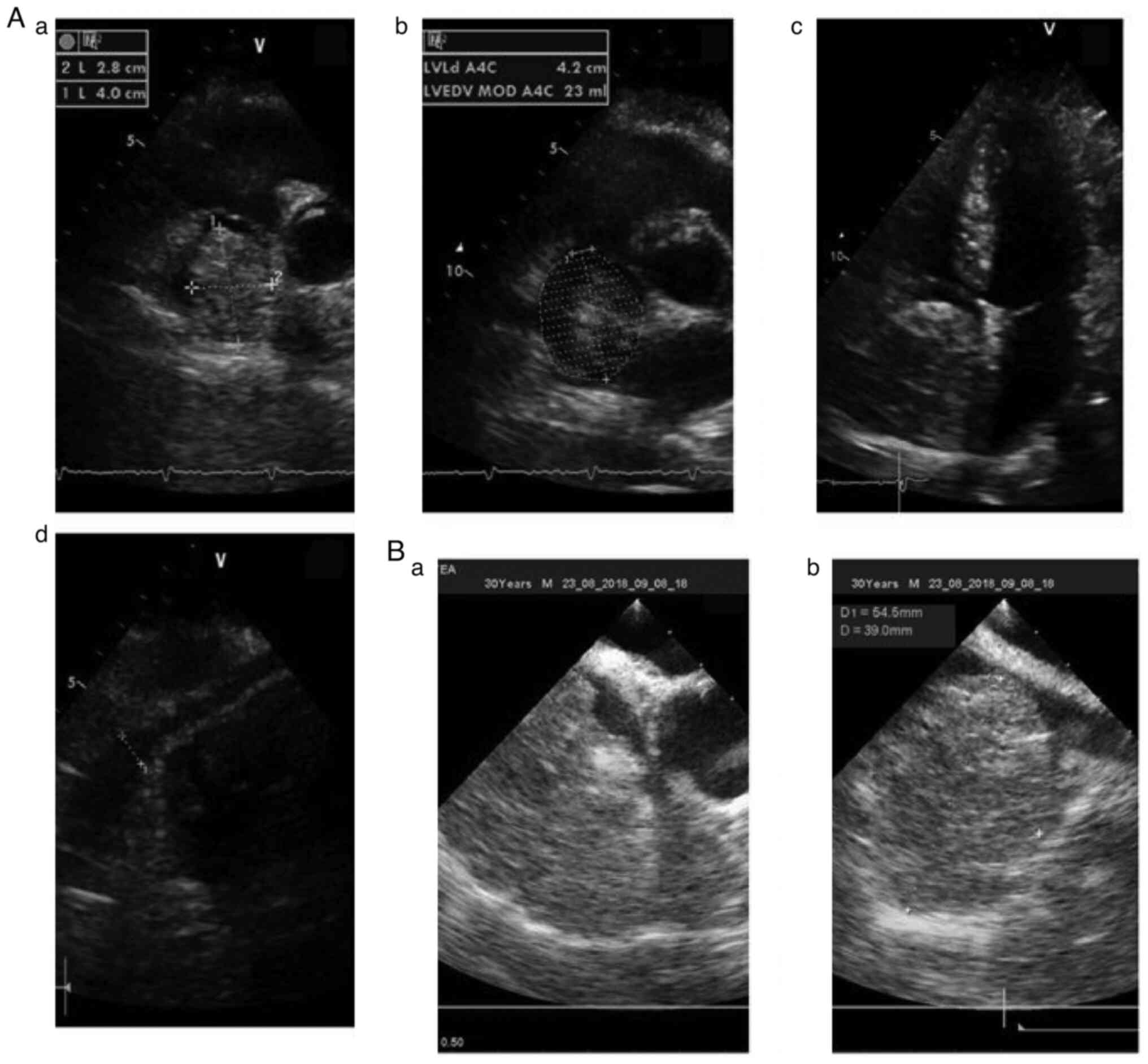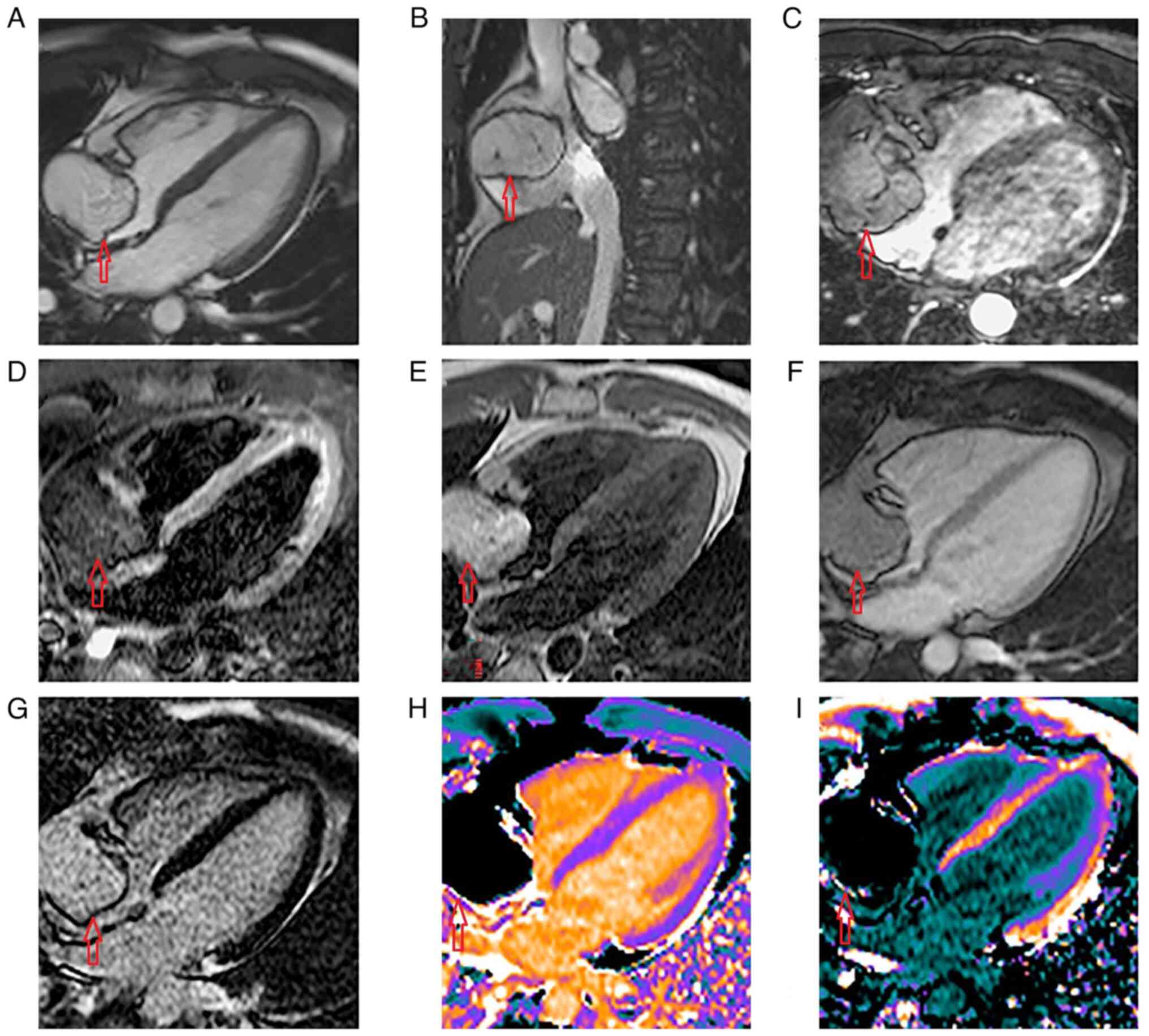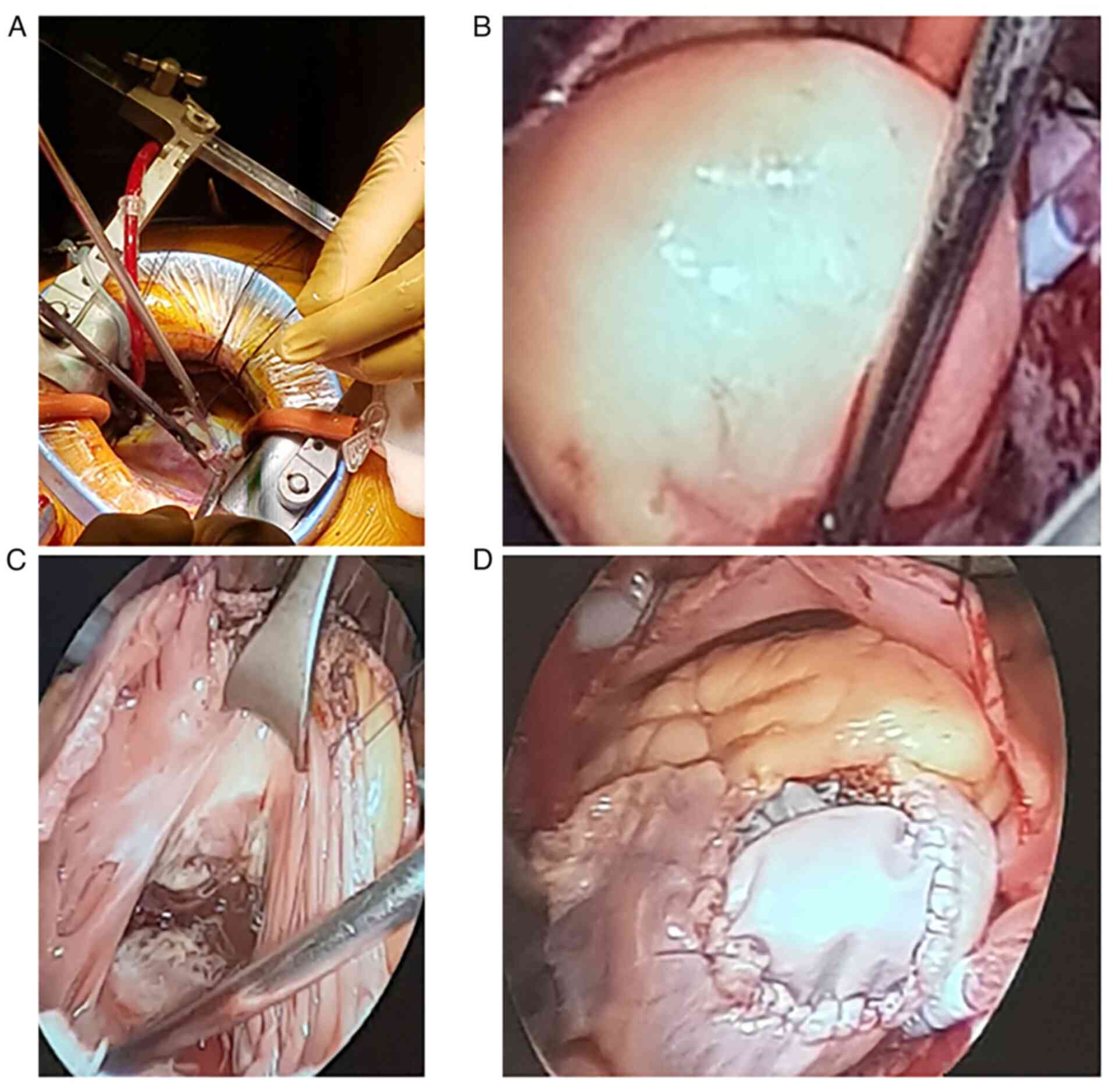Right atrial lipoma: A case report and literature review
- Authors:
- Published online on: September 28, 2022 https://doi.org/10.3892/etm.2022.11633
- Article Number: 697
-
Copyright: © Bajdechi et al. This is an open access article distributed under the terms of Creative Commons Attribution License.
Abstract
Introduction
The most common cardiac tumors in adults are metastatic tumors (1). In autopsies, the incidence of primary cardiac tumors is <0.2% (2). Cardiac lipomas are rare entities, with a 2.9-8% incidence among all benign cardiac tumors, which positions them at the third place after myxomas and papillary fibroelastomas (3). Most cardiac lipomas do not cause symptoms, but they can be fatal when they cause arrhythmic or obstructive symptoms (1). They can be associated with symptoms that are related to the size and location (4). For example, lipomas that are large can cause left ventricular outflow tract obstruction and lead to symptoms ranging from syncope to cardiogenic shock, while lipomas situated near the atrioventricular valves can lead to valvular insufficiency or stenosis and manifest clinically as heart failure. The current case report presented a rare case of a large right atrial (RA) mass, in a completely asymptomatic patient who was in the otolaryngology service for a frontal osteoma resection.
Echocardiography is the most useful imaging technique to diagnose cardiac tumors due to its availability, accuracy and safety, but cardiac magnetic resonance can better characterize the tumors (5). In this case, echocardiography revealed the tumor and cardiac magnetic resonance raised the suspicion of cardiac lipoma, but the differential diagnosis with a liposarcoma remained. Conservative management requires periodic clinical and echocardiographic monitoring. Surgery is the treatment of choice and is considered curative, but the risk-benefit ratio must be considered, and shared decision making must be taken into account. Whether one approach is superior to the other is unknown (6). Due to the lack of large studies on cardiac lipomas, there are no exact data regarding risk factors or mortality in these patients; however, literature reviews can be helpful.
Case report
In February 2018, a 30-year-old male was admitted to the Otolaryngology service of the Coltea Clinical Hospital (Bucharest, Romania) for a frontal osteoma resection. The patient was completely asymptomatic, with good effort tolerance, practicing sports during adolescence, without significant family history. The physical examination did not yield any pathological results. In addition, laboratory tests were within normal limits: Hemoglobin level, 15.7 g/dl (normal limits, 14-17 g/dl); white blood cell count, 7,600/µl (normal limits, 4,000-11,000/µl; C reactive protein, 0.31 mg/dl (normal limits, 0-0.32 mg/dl); and D-Dimer, 0.23 (normal limits, 0-0.5 µg/ml).
Preoperative standard twelve-lead electrocardiogram (Fig. 1) showed sinus rhythm, ventricular rate of 83 beats per minute ‘pulmonale P waves’ (tall and peaked, height of 3 mm in D II) and QRS with right bundle branch block aspect. The findings suggested the presence of RA enlargement. Because of these electrical abnormalities, the patient was sent to the cardiologist. Transthoracic echocardiogram showed a large mass occupying the right atrium (40x28 mm), oval-shaped, hyperechoic, homogenous, with borders attached to the free wall of the right atrium (Fig. 2Aa-Ac), which was compatible with a benign tumoral mass. Inferior vena cava was normal (Fig. 2Ad). Transesophageal echocardiogram was performed to appreciate better the mass and to search for associated abnormalities and indicated the size of the atrial tumor (54x39 mm) (Fig. 2Ba and Bb). To improve tumor characterization and differential diagnosis, cardiac magnetic resonance was considered appropriate. Cardiac magnetic resonance showed a large mass originating on the RA lateral wall and occupying almost the entire RA cavity without any contact with the inter-atrial septum (Fig. 3A; cine 4 chamber view), which did not interfere with the blood flow from either superior or inferior vena cava (Fig. 3B; cine bi-caval view). The three-dimensional whole heart sequence revealed that the mass had a poli-lobulated and septate appearance (Fig. 3C). The mass was hypointense in T2-weighted short inversion time inversion recovery (Fig. 3D). In T1-weighted turbo spin-echo dark blood sequence, the mass appeared hyperintense (Fig. 3E). Early gadolinium enhancement imaging showed no evidence of thrombus attached to the surface of the mass (Fig. 3F) and late gadolinium enhancement imaging with a time of inversion chosen for myocardial nulling showed homogenous intensity of the RA mass (Fig. 3G). Advanced tissue characterization techniques (T1 mapping) were performed that definitely identified the lipomatous nature of the RA mass: Native T1 maps showed homogenous and significantly lower T1 values 250 msec of the mass compared with the normal myocardium and blood, while it was similar to subcutaneous and epicardial fat (Fig. 3H). Post-contrast administration T1 mapping of the RA mass showed a T1 of 260 msec, similar to the native T1 value, indicating that the tumor did not retain contrast (Fig. 3I). These findings were consistent with a diagnosis of cardiac lipoma.
The patient was referred with their consent to cardiac surgery where the option was the excision of the tumor. Further, the RA wall was reconstructed with ‘XenoSure’ patch (LeMaitre Vascular, Inc.) in extracorporeal circulation through a minimally invasive approach (right mini-thoracotomy). The intervention was performed under general anesthesia with selective intubation. Transesophageal echocardiography monitoring was set up. A 4-cm incision was made in the right groin and the femoral vessels were dissected. Extracorporeal circulation was performed through the insertion of a right femoral artery cannula (size 20) and two venous derivations (the superior cava vein percutaneous using a cannula size 17 and the inferior cava vein through the right femoral vein using a long venous cannula size 25). Right mini-thoracotomy was performed in the third intercostal right space (Fig. 4A). After lung deflation, lateral pericardiotomy was performed (3 cm anterior to the phrenic nerve) and a cardioplegia cannula was applied. Myocardial protection was achieved via administration of anterograde cardioplegia in the aortic bulb, thereby inducing hypothermia at 34˚C. Inspection of the right atrium revealed dilated atrium due to the tumor invasion of the anterior atrial wall (Fig. 4B).
A 5-cm long right atriotomy was performed. Exposure revealed a lipomatous mass, oval in shape, encapsulated, with estimated dimensions of 6.5x5.5x3.5 cm (Fig. 5A), attached to the anterior wall of the right atrium. The tumor was removed along with the implantation base from the anterior wall of the right atrium (Fig. 4C). Reconstruction of the right atrium was operated with a ‘XenoSure’ patch of 4/5 cm sutured with Prolene 5.0. The right atriotomy was closed using continuous Prolene 5.0 running suture (Fig. 4D). The bypass was stopped after rewarming the patient to 36.5˚C. The total operative time was 120 min. After the surgery, transesophageal echocardiography examination was performed and did not show any complications.
The sampled tissue was fixed with formalin (10%) for 18-24 h at 22˚C, then the sections were placed in paraffin blocks. The thickness of tissue section was 2-3 µm, and it was sent for histopathological analysis by the Department of Pathology, where a light microscope was used for analysis. Hematoxylin and eosin staining of the specimen revealed mature white adipose tissue without atypia, findings consistent with a lipoma (Fig. 5B). Short-term evolution was favorable, with rapid clinical recovery.
At the 1-year follow-up, conventional echocardiography was normal, with no signs of atrial enlargement and aforementioned echocardiographic changes resolved.
Discussion
Cardiac lipomas may be asymptomatic even in large dimensions and are typically found incidentally on autopsies or via imaging methods (1,4). Regarding their incidence, there are no differences between age groups or sexes (4). Cardiac lipomas can be associated with symptoms that are related to the size and location of the lipoma (1,4). The present one is a rare case, where the tumor was large and asymptomatic. The etiology of cardiac lipomas is unknown. The origin of lipomas can be from all the three cardiac tissues: Subendocardial (the majority), pericardial or myocardial (7).
They are usually encapsulated masses, but sometimes they can infiltrate the walls of the heart (4). The most common complications of these tumors can be due to intracardiac obstruction of blood flow, which can cause symptoms varying from fatigue to even syncope (4), or electrical disorders such as atrioventricular or intraventricular conduction disorders, which are manifested by arrhythmias, interfering in the cardiac dynamic and leading to sudden death (8,9). In the present case, the patient had right bundle branch block and abnormal P wave, which resigned after the surgery. Pulmonary thromboembolism and pericardial effusion have also been reported in certain studies (10-13). An intra-aortic lipoma, that invaded the left coronary ostium and was responsible for sudden cardiac death in a 52-year-old man was reported (9).
Echocardiography is the most useful imaging technique to diagnose cardiac tumors due to its large availability, accuracy and safety (14). Surgery is the treatment of choice in these cases, but the risk-benefit ratio must be considered, and shared decision making must be taken into account. Shared decision making is not widely used in Romania, and it depends on numerous factors, such as the level of education (15). Shared decision making is very important as these patients are subjected to significant mental stress, being sent for cardiac surgery even though they are asymptomatic.
After reviewing the literature, only one case of RA lipoma treated via a minimally invasive cardiac surgery technique was found (16). The main particularities of the case were the absence of clinical signs considering the dimensions of the tumor (6.5x5.5x3.5 cm; no right ventricular filling abnormalities) and the minimally invasive cardiac surgery technique, which was also permissive for rapid recovery of the patient. Cardiac lipomas are rare entities, with a 2.9-8% incidence among all benign cardiac tumors (2). Reviewing the location of cardiac lipomas revealed that ~40% were in the right atrium (4).
In the present study, a short PubMed literature review (https://pubmed.ncbi.nlm.nih.gov/) was performed to analyze the RA lipoma cases reported from 1995-2021. Search criteria included the following key words: ‘Right atrial lipoma’. The cases that had patients <16 years of age and with patients that had no follow-up data were excluded. Collected data are illustrated in Table I. A total of 26 cases of RA lipomas with available details were found. Among these cases, no significant difference in the distribution between genders (13 female, 12 male and 1 transgender) was found. The median age of the included patients was 55.5 years old (age range, 17-74 years).
Cardiac tumors may cause clinical presentation via different pathways. Symptoms related to RA lipoma were present in 21 out of 26 patients (80%). The symptoms varied greatly, dyspnea being the most common of them (35%), followed by chest pain (15%) and palpitation (12%). Although it has been reported that cardiac lipomas are generally silent (4), the present literature review, which included RA lipomas, showed that only 5 out of 26 patients (19%) were completely asymptomatic. In one particular case, the lipoma was found during the autopsy of a patient with sudden death (8).
Large cardiac lipomas can lead to complications such as obstruction of ventricular outflow tract, electrical disorders, embolism or pericardial effusion (10,12,13,17). Obstruction of right ventricular outflow tract was reported in 11 out of 26 patients (42%) diagnosed with RA lipoma (2,16-25).
Generally, atrial lipomas can have various sizes (4). In the present review, the largest lipoma was 25 cm and was found in a 17-year-old girl in 1995(18).
The most useful imaging technique was transthoracic echocardiography. Among these patients, 9 out of 26 cases (35%) of RA lipoma underwent cardiac magnetic resonance for a better tumor characterization. Accurate diagnosis and evaluation of cardiac lipomas is therefore dependent on multimodality imaging methods.
The present literature review showed that 23 out of 25 patients (92%) underwent surgery. Among these patients, only 1 out of 23 received a minimally invasive approach in 2021(16). Minimally invasive surgical techniques should be considered in certain patients with cardiac lipoma in the future.
Acknowledgements
Not applicable.
Funding
Funding: No funding was received.
Availability of data and materials
All data generated or analyzed during this study are included in this published article.
Authors' contributions
MB is the corresponding author and participated in the design of the case report. SO performed and described the cardiac magnetic resonance. VC performed and described the surgery. SB performed the histopathology. AG performed additional literature review and revised the draft. MB and AG confirm the authenticity of all the raw data. All authors read and approved the final version of the manuscript.
Ethics approval and consent to participate
Ethics approval was obtained from the Medical Ethics Committee of Coltea Clinical Hospital (approval no. 26/07.12.2021).
Patient consent for publication
Written informed consent was obtained from the patient prior to publication at the time of admission.
Competing interests
The authors declare that they have no competing interests.
References
|
Singh S, Singh M, Kovacs D, Benatar D, Khosla S and Singh H: A rare case of a intracardiac lipoma. Int J Surg Case Rep. 9:105–108. 2015.PubMed/NCBI View Article : Google Scholar | |
|
Wu S, Teng P, Zhou Y and Ni Y: A rare case report of giant epicardial lipoma compressing the right atrium with septal enhancement. J Cardiothorac Surg. 10(150)2015.PubMed/NCBI View Article : Google Scholar | |
|
Valenti V, Zia MI, Uretsky S and Wolff SD: Intra-myocardial left ventricular lipoma associated with non-compaction cardiomyopathy. Eur Heart J Cardiovasc Imaging. 13(963)2012.PubMed/NCBI View Article : Google Scholar | |
|
Shu S, Wang J and Zheng C: From pathogenesis to treatment, a systemic review of cardiac lipoma. J Cardiothorac Surg. 16(1)2021.PubMed/NCBI View Article : Google Scholar | |
|
Altbach MI, Squire SW, Kudithipudi V, Castellano L and Sorrell VL: Cardiac MRI is complementary to echocardiography in the assessment of cardiac masses. Echocardiography. 24:286–300. 2007.PubMed/NCBI View Article : Google Scholar | |
|
Abdelradi A and Yekta A: A case of asymptomatic cardiac lipoma and literature review. CJC Open. 3:207–209. 2020.PubMed/NCBI View Article : Google Scholar | |
|
Naseerullah FS, Javaiya H, Murthy A, Heart SI, Place SW and Vernon M: Cardiac lipoma : An uncharacteristically large intra-atrial mass causing symptoms. Case Rep Cardiol. 2018:3–6. 2018.PubMed/NCBI View Article : Google Scholar | |
|
D'Errico S, Mazzanti A, Frati P and Fineschi V: Conduction disorder and primary cardiac tumor: A fatal case of multiple lipomas of the right atrium. J Geriatr Cardiol. 16:431–433. 2019.PubMed/NCBI View Article : Google Scholar | |
|
Bagwan IN and Sheppard MN: Cardiac lipoma causing sudden cardiac death. Eur J Cardiothorac Surg. 35(727)2009.PubMed/NCBI View Article : Google Scholar | |
|
Miller CA and Schmitt M: Epicardial lipomatous hypertrophy mimicking pericardial effusion: Characterization with cardiovascular magnetic resonance. Circ Cardiovasc Imaging. 4:77–78. 2011.PubMed/NCBI View Article : Google Scholar | |
|
Liu L, Zuo Y, Huang Y and Cao L: Echocardiographical findings of giant cardiac lipoma. Medicine (Baltimore). 98(e14456)2019.PubMed/NCBI View Article : Google Scholar | |
|
Steinberg I, Sherman RS and Waldman I: Intrapericardial lipoma simulating pericardial effusion. Report of two cases. Radiology. 81:949–952. 1963.PubMed/NCBI View Article : Google Scholar | |
|
Steger CM: Intrapericardial giant lipoma displacing the heart. ISRN Cardiol. 2011(243637)2011.PubMed/NCBI View Article : Google Scholar | |
|
Gurghean AL, Savulescu-Fiedler I and Mihailescu A: Multiple cardiac complications after adjuvant therapy for breast cancer: The importance of echocardiography. A case report and review of the literature. Med Ultrason. 19:117–120. 2017.PubMed/NCBI View Article : Google Scholar | |
|
Baicus C, Balanescu P, Zeh S, Oprisan E, Lapadatu R, Gurghean A, Padureanu V, Rezus C, Mitu F, Jurcut R, et al: Characteristics of shared decision making in Romania from the patient perspective: A cross-sectional multicentric study. J Eval Clin Pract. 25:1152–1159. 2019.PubMed/NCBI View Article : Google Scholar | |
|
Molek P, Urbańczyk-Zawadzka M, Mielnik M, Szlosarczyk B, Nessler J and Gackowski A: Right atrial lipoma: The significance of multimodality imaging. Kardiol Pol. 79:893–894. 2021.PubMed/NCBI View Article : Google Scholar | |
|
Chien RN, Kao JH, Peng CY, Chen CH, Liu CJ, Huang YH, Hu TH, Yang HI, Lu SN, Ni YH, et al: Taiwan consensus statement on the management of chronic hepatitis B. J Formos Med Assoc. 118:7–38. 2019.PubMed/NCBI View Article : Google Scholar | |
|
Mullen JC, Schipper SA, Sett SS and Trusler GA: Right atrial lipoma. Ann Thorac Surg. 59:1239–1241. 1995.PubMed/NCBI View Article : Google Scholar | |
|
Lapinskas T, Kouwenhoven M, Schnackenburg B, Bigvava T, Wassilew K, Gebker R, Jacobs S, Zaliunas R, Pieske B and Kelle S: Cardiac MRI quantitative tissue characterization of right atrial mass using mDixon and parametric mapping. Clin Res Cardiol. 106:840–845. 2017.PubMed/NCBI View Article : Google Scholar | |
|
Sankar NM, Thiruchelvam T, Thirunavukkaarasu K, Pang K and Hanna WM: Symptomatic lipoma in the right atrial free wall. A case report. Tex Hear Inst J. 25:152–154. 1998.PubMed/NCBI | |
|
Maurea N, Mollo A, Boccalatte M, Esposito S, Agozzino L and Bellitti R: Lipoma of the heart: A case report. Ital Heart J. 2:621–623. 2001.PubMed/NCBI | |
|
Pego-Fernandes PM, Costa PL, Fernandes F, Benvenuti LA and Oliveira SA: Right atrial lipoma. Arq Bras Cardiol. 80:97–99, 94-96. 2003.PubMed/NCBI View Article : Google Scholar : (In English, Portuguese). | |
|
Templin C, Ghadri JR, Wilkens L and Niehaus M: Difficult differential diagnosis of a right atrial intracardiac mass. Int J Cardiol. 125:e19–e20. 2008.PubMed/NCBI View Article : Google Scholar | |
|
Smith MA: Multiple synchronous atrial lipomas. Cardiovasc Pathol. 16:187–188. 2007.PubMed/NCBI View Article : Google Scholar | |
|
Gulmez O, Pehlivanoglu S, Turkoz R, Demiralay E and Gumus B: Lipoma of the right atrium. J Clin Ultrasound. 37:185–188. 2009.PubMed/NCBI View Article : Google Scholar | |
|
Joaquim MR, Braile DM, Arruda MV and Soares MJ: Right atrial lipoma resection and partial reconstruction using bovine pericardium. Rev Bras Cir Cardiovasc. 24:239–241. 2009.PubMed/NCBI View Article : Google Scholar | |
|
Ceresa F, Calarco G, Franzì E and Patanè F: Right atrial lipoma in patient with Cowden syndrome. Interact Cardiovasc Thorac Surg. 11:803–804. 2010.PubMed/NCBI View Article : Google Scholar | |
|
Alameddine AK, Alimov VK, Turner GS and Deaton DW: Surgical pitfalls of excising an intramyocardial lipoma. J Thorac Cardiovasc Surg. 141:592–594. 2011.PubMed/NCBI View Article : Google Scholar | |
|
Habertheuer A, Andreas M, Wiedemann D, Rath C and Kocher A: A rare case of obstructive right atrial lipoma. Ann R Coll Surg Engl. 96:e39–e41. 2014.PubMed/NCBI View Article : Google Scholar | |
|
Barbuto L, Ponsiglione A, Del Vecchio W, Altiero M, Rossi G, De Rosa D, Pisani A and Imbriaco M: Humongous right atrial lipoma: A correlative CT and MR case report. Quant Imaging Med Surg. 5:774–777. 2015.PubMed/NCBI View Article : Google Scholar | |
|
Khalili A, Ghaffari S, Jodati A, Shokoohi B and Pourafkari L: Giant right atrial lipoma mimicking tamponade. Asian Cardiovasc Thorac Ann. 23:317–319. 2015.PubMed/NCBI View Article : Google Scholar | |
|
Wang H, Hu J, Sun X, Wang P and Du Z: An asymptomatic right atrial intramyocardial lipoma: A management dilemma. World J Surg Oncol. 13(20)2015.PubMed/NCBI View Article : Google Scholar | |
|
Rainer WG, Bailey DJ and Hollis HW Jr: Giant cardiac lipoma: Refined hypothesis proposes invagination from extracardiac to intracardiac sites. Texas Hear Inst J. 43:461–464. 2016.PubMed/NCBI View Article : Google Scholar | |
|
Wahab A, Chaudhary S, Munir A and Smith SJ: Lipoma of superior vena cava: A rare occurrence. BMJ Case Rep: Jul 24, 2017 (Epub ahead of print). | |
|
Shah OA, Badran A, Kaarne M and Velissaris T: Right atrial and SVC infiltrating mass-the entity of infiltrating lipoma. J Cardiothorac Surg. 14(210)2019.PubMed/NCBI View Article : Google Scholar | |
|
Wang X, Yu X, Ren W and Li D: A case report: A giant cardiac atypical lipoma associated with pericardium and right atrium. BMC Cardiovasc Disord. 19(247)2019.PubMed/NCBI View Article : Google Scholar | |
|
Bath AS, Gupta V and Kalavakunta JK: A right atrial fat ball: Rare case of cardiac lipoma. Clin Case Rep. 7:1798–1799. 2019.PubMed/NCBI View Article : Google Scholar | |
|
Fan W, Liao B and Li X: Lipoma across the wall of the right atrium. J Card Surg. 36:3390–3392. 2021.PubMed/NCBI View Article : Google Scholar |














